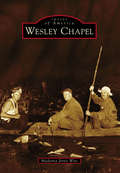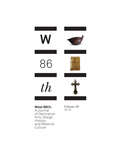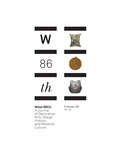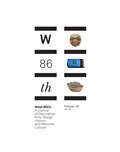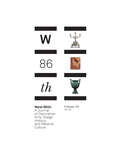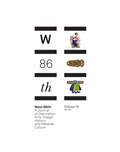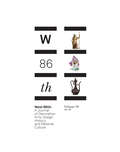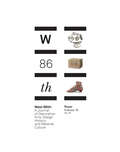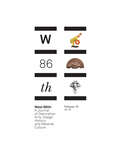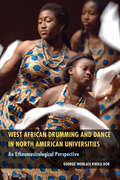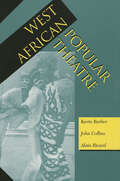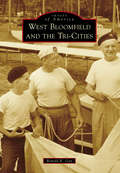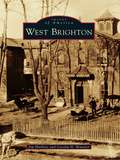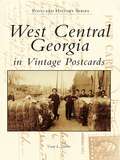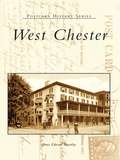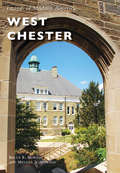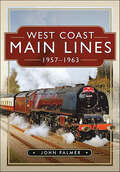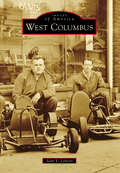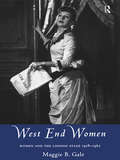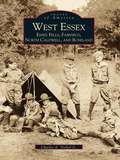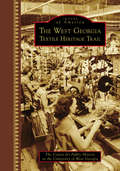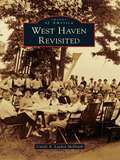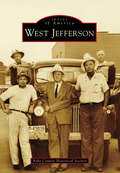- Table View
- List View
Wes Craven: Interviews (Conversations with Filmmakers Series)
by Shannon Blake SkeltonWith a career spanning four decades, Wes Craven (1939–2015) bridged independent exploitation cinema and Hollywood big-budget horror. A pioneer of the modern horror cinema, Craven directed such landmark films as The Last House on the Left, The Hills Have Eyes, A Nightmare on Elm Street, and Scream—considered not only classics of the genre, but examples of masterful filmmaking. Producing an impressive oeuvre that mixed intellectual concerns and political ideas, Craven utilized high-tension suspense, devastating visual brutality, and dark humor to evoke a unique brand of fear. Moreover, his films draw attention to the horror of American society—namely racism, classism, and the traumas often associated with family. This collection of twenty-nine interviews—spanning from 1980 until his final interview in 2015—traces Craven’s life and career, from his upbringing in a strict religious family and his life as an academic to his years toiling in exploitation cinema. The volume also chronicles Craven’s ascendancy as an independent director, his work within the studio system, and his eventual triumph in mainstream cinema. Within the interviews gathered here, including three previously unpublished pieces, Craven reflects on failed projects and the challenges of working with studios while offering thoughtful meditations on the dynamics and appeal of horror. Wes Craven: Interviews cements Craven’s legacy as a master of horror who left an indelible mark on the genre by forever altering expectations of—and approaches to—the cinema of fear.
Wesley Chapel (Images of America)
by Madonna Jervis WiseWesley Chapel originated in the mid-1800s as a cohesive community of settlers who demonstrated a uniquely rural authenticity and independence of spirit. Evidence of Native American presence in the area has been documented as early as 10,000 BC. Lumber harvesting and turpentine production became prominent industries, while cash-crop farming, citrus, and livestock ranching provided sustenance for the pioneer settlement. Charcoal kilns, gator hunting, and moonshine stills supplemented incomes and spawned legends. The community was also identified by the monikers Gatorville, Double Branch, and Godwin. From 1897 to 1902, Wesley Chapel boasted its own post office, two sawmills, and a general store. Primitive roads left residents with an informal town nucleus, and services shifted to surrounding towns until the late 20th century, when postal service and incorporation emerged, and the lumber trusts of John D. Rockefeller, Otto Hermann Kahn, and Edwin Wiley morphed into sizeable ranches.
West 86th: A Journal of Decorative Arts, Design History, and Material Culture, volume 28 number 1 (Spring-Summer 2021)
by West 86th: A Journal of Decorative Arts, Design History, and Material CultureThis is volume 28 issue 1 of West 86th: A Journal of Decorative Arts, Design History, and Material Culture. Focusing on the decorative arts, design history, and material culture, West 86th provides a forum for new research into all aspects of the content, meaning, and significance of material objects in history. West 86th publishes scholarly articles; review articles; primary source translations; critical book, catalogue, and exhibition reviews; research inquiries; letters to the editor; and supplementary digital material integral to articles.
West 86th: A Journal of Decorative Arts, Design History, and Material Culture, volume 28 number 2 (Fall-Winter 2021)
by West 86th: A Journal of Decorative Arts, Design History, and Material CultureThis is volume 28 issue 2 of West 86th: A Journal of Decorative Arts, Design History, and Material Culture. Focusing on the decorative arts, design history, and material culture, West 86th provides a forum for new research into all aspects of the content, meaning, and significance of material objects in history. West 86th publishes scholarly articles; review articles; primary source translations; critical book, catalogue, and exhibition reviews; research inquiries; letters to the editor; and supplementary digital material integral to articles.
West 86th: A Journal of Decorative Arts, Design History, and Material Culture, volume 29 number 1 (Spring-Summer 2022)
by West 86th: A Journal of Decorative Arts, Design History, and Material CultureThis is volume 29 issue 1 of West 86th: A Journal of Decorative Arts, Design History, and Material Culture. Focusing on the decorative arts, design history, and material culture, West 86th provides a forum for new research into all aspects of the content, meaning, and significance of material objects in history. West 86th publishes scholarly articles; review articles; primary source translations; critical book, catalogue, and exhibition reviews; research inquiries; letters to the editor; and supplementary digital material integral to articles.
West 86th: A Journal of Decorative Arts, Design History, and Material Culture, volume 29 number 2 (Fall-Winter 2022)
by West 86th: A Journal of Decorative Arts, Design History, and Material CultureThis is volume 29 issue 2 of West 86th: A Journal of Decorative Arts, Design History, and Material Culture. Focusing on the decorative arts, design history, and material culture, West 86th provides a forum for new research into all aspects of the content, meaning, and significance of material objects in history. West 86th publishes scholarly articles; review articles; primary source translations; critical book, catalogue, and exhibition reviews; research inquiries; letters to the editor; and supplementary digital material integral to articles.
West 86th: A Journal of Decorative Arts, Design History, and Material Culture, volume 30 number 1 (Spring-Summer 2023)
by West 86th: A Journal of Decorative Arts, Design History, and Material CultureThis is volume 30 issue 1 of West 86th: A Journal of Decorative Arts, Design History, and Material Culture. Focusing on the decorative arts, design history, and material culture, West 86th provides a forum for new research into all aspects of the content, meaning, and significance of material objects in history. West 86th publishes scholarly articles; review articles; primary source translations; critical book, catalogue, and exhibition reviews; research inquiries; letters to the editor; and supplementary digital material integral to articles.
West 86th: A Journal of Decorative Arts, Design History, and Material Culture, volume 30 number 2 (Fall-Winter 2023)
by West 86th: A Journal of Decorative Arts, Design History, and Material CultureThis is volume 30 issue 2 of West 86th: A Journal of Decorative Arts, Design History, and Material Culture. Focusing on the decorative arts, design history, and material culture, West 86th provides a forum for new research into all aspects of the content, meaning, and significance of material objects in history. West 86th publishes scholarly articles; review articles; primary source translations; critical book, catalogue, and exhibition reviews; research inquiries; letters to the editor; and supplementary digital material integral to articles.
West 86th: A Journal of Decorative Arts, Design History, and Material Culture, volume 31 number 1 (Spring-Summer 2024)
by West 86th: A Journal of Decorative Arts, Design History, and Material CultureThis is volume 31 issue 1 of West 86th: A Journal of Decorative Arts, Design History, and Material Culture. Focusing on the decorative arts, design history, and material culture, West 86th provides a forum for new research into all aspects of the content, meaning, and significance of material objects in history. West 86th publishes scholarly articles; review articles; primary source translations; critical book, catalogue, and exhibition reviews; research inquiries; letters to the editor; and supplementary digital material integral to articles.
West 86th: A Journal of Decorative Arts, Design History, and Material Culture, volume 31 number 2 (Fall-Winter 2024)
by West 86th: A Journal of Decorative Arts, Design History, and Material CultureThis is volume 31 issue 2 of West 86th: A Journal of Decorative Arts, Design History, and Material Culture. Focusing on the decorative arts, design history, and material culture, West 86th provides a forum for new research into all aspects of the content, meaning, and significance of material objects in history. West 86th publishes scholarly articles; review articles; primary source translations; critical book, catalogue, and exhibition reviews; research inquiries; letters to the editor; and supplementary digital material integral to articles.
West African Drumming and Dance in North American Universities: An Ethnomusicological Perspective
by George Worlasi DorMore than twenty universities and twenty other colleges in North America (USA and Canada) offer performance courses on West African ethnic dance drumming. Since its inception in 1964 at both UCLA and Columbia, West African drumming and dance has gradually developed into a vibrant campus subculture in North America. The dances most practiced in the American academy come from the ethnic groups Ewe, Akan, Ga, Dagbamba, Mande, and Wolof, thereby privileging dances mostly from Ghana, Togo, Benin, Senegal, Mali, Guinea, and Burkina Faso. This strong presence and practice of a world music ensemble in the diaspora has captured and engaged the interest of scholars, musicians, dancers, and audiences. In the first-ever ethnographic study of West African drumming and dance in North American universities, the author documents and acknowledges ethnomusicologists, ensemble directors, students, administrators, and academic institutions for their key roles in the histories of their respective ensembles. Dor collates and shares perspectives including debates on pedagogical approaches that may be instructive as models for both current and future ensemble directors and reveals the multiple impacts that participation in an ensemble or class offers students. He also examines the interplay among historically situated structures and systems, discourse, and practice, and explores the multiple meanings that individuals and various groups of people construct from this campus activity. The study will be of value to students, directors, and scholars as an ethnographic study and as a text for teaching relevant courses in African music, African studies, ethnomusicology/world music, African diaspora studies, and other related disciplines.
West African Popular Theatre (Drama And Performance Studies)
by John Collins Alain Ricard Karin Barber" . . . a ground-breaking contribution to the field of African literature . . . " —Research in African Literatures"Anyone with the slightest interest in West African cultures, performance or theatre should immediately rush out and buy this book." —Leeds African Studies Bulletin"A seminal contribution to the fields of performance studies, cultural studies, and popular culture. " —Margaret Drewal"A fine book. The play texts are treasures." —Richard BaumanAfrican popular culture is an arena where the tensions and transformations of colonial and post-colonial society are played out, offering us a glimpse of the view from below in Africa. This book offers a comparative overview of the history, social context, and style of three major West African popular theatre genres: the concert party of Ghana, the concert party of Togo, and the traveling popular theatre of western Nigeria.
West Bloomfield and the Tri-Cities
by Ronald K. GayWest Bloomfield Township, located 30 miles northwest of Detroit, was carved from Bloomfield Township in 1833. There were settlements in nearby Pontiac as early as 1818 and in Bloomfield by 1820. The area, originally settled by Native Americans, became a farming community when it was later occupied by European settlers. Towns grew and prospered due to the large number of lakes and later with the advent of the local automotive industry. Around the start of the 20th century, Orchard Lake became an established village, and Sylvan Lake Village and Keego Harbor were beginning to take shape. Over the years, there have been five country clubs, an automobile club, two boat clubs, two camps, a curling club, a military academy, a seminary, and a prep school in the area. There have also been two summer resort hotels created in Orchard Lake, one in Sylvan Lake, and one in West Bloomfield on Pine Lake.
West Brighton
by Cecelia N. Brunner Jim HarkinsIn the late 19th century, West Brighton became known as "Factoryville" after several industries set up shop in the vicinity. One of the largest, Barrett, Nephews, and Company, a dyeing and cleaning establishment, employed hundreds of Staten Islanders. Several prominent historical figures have resided in the region as well, including former first lady Julia Gardiner Tyler, who, in 1862, left the Confederacy (but not her Southern sympathies) to rejoin her family in West Brighton upon the death of former U.S. president John Tyler. The neighborhood is also the home of the famed Staten Island Zoo; the idyllic beauty of Silver Lake, Clove Lakes, and Walker Park lie within walking distance. But the most enduring trait of West Brighton is its people--the generations of families that have put down roots in one of the most scenic communities on Staten Island.
West Brookfield (Images of America)
by William Jankins Brenda MettervilleOriginally a part of Quaboag Plantation, the town of West Brookfield became independent by incorporating in 1848. Early industries included brickyards and factories for bookbinding and the manufacture of boots, hats, corsets, and condensed milk. The community's earliest days were also committed to education as rural school districts were established, boasting original school buildings that were able to be used through the 1950s. Over the years, many notable residents emerged, including Judge Jedediah Foster, who assisted in drafting the Massachusetts Constitution, and famous suffragist Lucy Stone. Brothers Daniel and Ebenezer Merriam established a printing house and bookstore in West Parish Brookfield. Today, residents and visitors enjoy West Brookfield's most popular attractions: the Rock House Reservation features 196 acres of boulders and stone outcrops and the 315-acre Lake Wickaboag is the scene of winter and summer activities, from icehouses to a nationally recognized water-ski club. The Quaboag Historical Society was founded in 1895 and 120 years later is still a vital part of the community.
West Central Georgia in Vintage Postcards
by Gay L. DosterFrom the 1890s through the 1920s, the postcard was an extraordinarily popular means of communication, and many of the postcards produced during this "golden age" can today be considered works of art. Postcard photographers traveled the length and breadth of the nation snapping photographs of busy street scenes, documenting local landmarks, and assembling crowds of local children only too happy to pose for a picture. These images, printed as postcards and sold in general stores across the country, survive as telling reminders of an importantera in America's history. This fascinating new history of West Central Georgia showcases more than two hundred of the best vintage postcards available.
West Chester (Postcard History Series)
by Bruce Edward MowdayWest Chester has grown from the sleepy village originally known as Turk's Head in the 1700s to a bustling community hosting West Chester University, a thriving educational institution. The selection of West Chester as the seat of Chester County's government in 1785 led citizens to march on the town "armed with a field-piece, a barrel of whiskey, and other warlike munitions." Architect Thomas U. Walter, who designed the U.S. Capitol, was responsible for several classic town buildings.
West Chester: Six Walking Tours (Images of Modern America)
by Bruce E. Mowday Melissa A. MowdayWest Chester is a thriving modern American town that honors its historic past and has become a sought-after location to live. First known as Turks Head, the town was a frequent stop for travelers before the American Revolution. Later, Abraham Lincoln�s first campaign biography was printed in the town. West Chester is the seat of government for Chester County, one of the most affluent and best governed counties in the nation. West Chester and the county have been named repeatedly by a myriad of national publications as one of the top places to live, work, and raise a family in the United States. The community offers many exciting events during the year, including a professional bicycle race, parades, and art and restaurant festivals. West Chester�s famous residents include composer Samuel Barber and artist Horace Pippin.
West Coast Main Lines, 1957–1963
by John PalmerThroughout its length from London to Glasgow via Crewe and Carlisle, with a loop through the West Midlands and spurs to Holyhead,Liverpool and Manchester, the West Coast Main Line has consistently provided interest for those many with more than a passing interest in trains and travel. This book outlines the history of the route,its physical characteristics and sets the scene for the various passenger and goods traffic flows that sustained it; it then details the arrangements for motive power and train working through the era of change that was 1957 to 1963. The level of interest - as evidenced daily by the presence at the lineside of hordes of young spotters and other observers - was particularly high at that time as processions of trains hauled by fine express passenger locomotives and those more suited to other traffic passed by. The book also goes 'behind the scenes' to provide insights into the daily and seasonal challenges of managing that section of a wider railway network, as directed by the varying terms of relevant legislation, and a government increasingly concerned to shape the railways for the changing needs of the public, industry and the economy. The book will be of particular interest to those who simply recall those days by the lineside, those with an interest in detailed arrangements to provide and maintain suitable motive power, those with an interest in how the railway served the needs of the nation and modellers who seek information. The book is illustrated with color and monochrome images and supported by maps.
West Columbus
by Sean V. LehositPresent-day West Columbus is a collective of neighborhoods born from the western banks of the Scioto River in what became Franklin County on April 30, 1803. The first settlement, Franklinton, was founded by Lucas Sullivant in 1797, platted two years after he received 6,000 acres in payment for surveying the central Ohio portion of the Virginia Military District. Later expansions included the areas of Sullivant's Hill, Rome, and Camp Chase. While the first settlers were farmers and ex-soldiers, the land would also attract Quakers, rail men, real estate moguls, and manufacturers. The neighborhoods found success even though the Scioto River, which birthed the region, on multiple occasions threatened to wash them off the map during three great floods. Characterized by a hardworking and driven population, the community attracted major investments by the mid-1900s, including the expanded operations of the General Motors Fisher Body Plant.
West End Women: Women and the London Stage 1918 - 1962 (Gender in Performance)
by Maggie GaleMaggie Gale's West End Women uncovers groundbreaking material about women playwrights and the staging of their performances between the years 1918 and 1962. It documents a dynamic era of social and theatrical history, analysing the transformations that occurred in the theatre and the lives of British women in relation to specific plays of the period. Focusing on the work of playwrights such as Dodie Smith, Clemence Dane, Gordon Daviot and Bridget Boland, Maggie Gale examines the cultural and political context within which they enjoyed commercial success and great notoriety.
West Essex, Essex Fells, Fairfield, North Caldwell, and Roseland
by Charles A. Poekel Jr.In 1702, a tract of land known as "Horseneck" was purchased by descendants of the Puritans from the Hackensack Indians for 130 pounds. The area, which consisted of over 13,500 acres of land, was located on the second Watchung Mountain from New York City. With conflicts between the Native American deeds and the grants from the East Jersey Proprietors whorepresented the Crown, land disputes ensued and resulted in the "Horseneck Riots" in 1744. These riots occurred when a prominent Horseneck farmer, Samuel Baldwin, was arrested and thrown into the Newark Jail. Within a few hours, 300 angry Horseneck farmers marched into the jail and freed him. This represented the first successful resistance against British tyranny, more than 30 years before Lexington and Concord. From this territory and from these early settlers were born the four communities of West Essex--Essex Fells, Fairfield, North Caldwell, and Roseland. From the Dutch origins of Fairfield to the planned suburban development of Essex Fells to the farms and estates of North Caldwell and Roseland, West Essex provides a photographic glimpse of the area, featuring over 200 images, many of whichhave never before been published. The impact of several important individuals is also noted, including Peter Van Ness, Willis H. Carrier, Madame Ernestine Schumann-Heink, and Henry Becker.
West Georgia Textile Heritage Trail, The
by The Center for Public History at the University of West GeorgiaThe textile industry powered the economic development of west and northwest Georgia in the 19th and 20th centuries. Several water-powered mills emerged in the antebellum period, but the late 19th century brought more growth as new technology allowed entrepreneurs to build cotton mills in towns and cities. The industry diversified in the 1920s, when hosiery mills moved to the region, and local businessmen established the apparel industry around Bremen. At the same time, a handicraft chenille business evolved in northwest Georgia, leading to the thriving carpet industry still centered in Dalton. Although many of the mills and plants have closed, the landscape of this region displays the strong presence of the textile industry. The West Georgia Textile Heritage Trail, a heritage tourism initiative extending from Columbus to Dalton, explores the rich history of these communities and the people who lived and worked in them.
West Haven Revisited
by Carole A. McelrathFor more than 350 years, the hardy southern New England coastal town of West Haven has made its mark on the nation's history. From the days when Pres. George Washington's fledgling government gave permission to install a dike at Oyster River to Pres. Barack Obama's recognition of the West Haven Black Heritage Committee's leaders, the town has reflected, in miniature, the growth of America. Important people like movie theater mogul Sylvester Z. Poli, his granddaughter Jeanne Poli, and the entrepreneurs who created Savin Rock Amusement Park helped shape West Haven's development. The town's history was also impacted by Queen Victoria and Robert Todd Lincoln's correspondence concerning the rededication of the Campbell grave site, the "Razorbacks connection," and the 1882 murder of Jennie Kramer.
West Jefferson
by Ashe County Historical SocietyWest Jefferson is located in the northwest corner of North Carolina, a land once known for its cherry orchards. In 1779, Col. Benjamin Cleveland, a hero of the Battle of King's Mountain, received a grant for 320 acres in a mountain valley in return for his service during the Revolutionary War. In 1912, the Virginia-Carolina Railroad became interested in the area's timber, farming, and mining resources and began building a railroad into Ashe County, ending at Todd. When the railroad came, the area was already populated by farms and businesses, as it was only two miles from the county seat of Jefferson. The North Carolina General Assembly chartered the town of West Jefferson in 1915, with boundaries extending one mile in each direction from the Virginia-Carolina Railroad depot. The railroad brought commercial growth, and the First National Bank of West Jefferson was opened in 1915 as well. West Jefferson showcases the expansion of this small town with a popular rail line to a tourist destination and retail center in the North Carolina mountains.

